OR/17/061 Summary of 2016 seismicity
| Galloway, D D. 2017. Bulletin of British Earthquakes 2016. Nottingham, UK, British geological Survey. (OR/17/061). |
There were 205 earthquakes located by the BGS seismic monitoring network during the year, with 22 having magnitudes of 2.0 ML or above and three having magnitudes of 3.0 ML or above. Two events with a magnitude of 2.0 ML or above were reported felt, together with a further thirteen smaller ones, bringing the total to fifteen felt earthquakes in 2016.
The largest earthquakes of the year occurred in the Northern North Sea on 9 September and on 3 November, both with a magnitude of 3.9 ML. The 9 September event was located approximately 275 km ENE of Lerwick, Shetland Islands and around 45 km SSE of the magnitude 4.8 ML North Sea earthquake on 26 July 1977. The 3 November event (Figure 5) was located approximately 280 km northeast of Aberdeen and is the largest earthquake in the general region (within 100 km) since a magnitude 4.7 ML on 23 March 1971. A further 20 events occurred in the North Sea and surrounding waters during the year, with magnitudes ranging between 1.5 ML and 3.8 ML. None were reported felt.
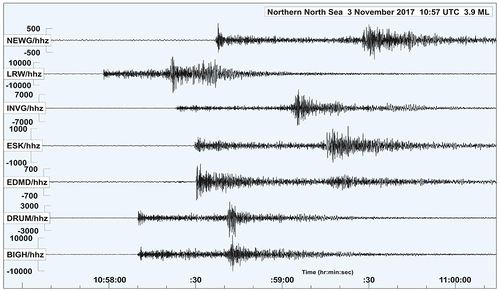
One of the largest onshore earthquakes during the year, with a magnitude of 2.3 ML, occurred on 27 October, at 02:08 UTC, and located approximately 9 km northwest of Liskeard, Cornwall (Figure 6). The BGS received some 45 reports from residents of Liskeard and the surrounding towns and villages who reported feeling the earthquake. Analysis of these reports shows that most of them came from within a 25 km radius of the epicentre. Typical reports described “the house shook slightly under my feet”, “the noise woke us up, then we felt the house tremble and the windows rattle”, “felt slight vibrations through my bed”, “it sounded like an underground train”, “the bedroom door creaked” and “it felt and sounded like a huge articulated lorry going over a speed bump outside the house”, indicating an intensity of 3 EMS. This is the largest event to occur in this region of Cornwall since the magnitude 2.7 ML earthquake on 12 June 1981, which was felt, mostly between Liskeard and Plymouth, with a maximum intensity of 4 EMS. Historically, the largest earthquakes to have occurred nearby, within 20 km, were the magnitude 4.2 ML Launceston event that occurred on 25 June 1883, which was felt throughout Cornwall and Devon and the magnitude 3.4 ML Callington event that occurred on 12 August 1852, which was felt over most of east Cornwall. Minor damage, mainly damage to plaster, was reported for both these events indicating a maximum intensity of between 5 and 6 EMS.
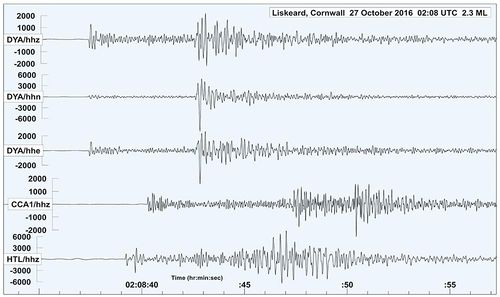
Another earthquake with a magnitude of 2.3 ML occurred during the year, at 23:12 UTC on 6 March with an epicentre approximately 4 km southeast of Thame, Oxfordshire (Figure 7). The BGS received several felt reports from residents in the villages of Chinnor and Watlington (Oxfordshire) and from Bledlow, Bledlow Ridge, Princes Risborough, Monks Risborough and Aylesbury (Buckinghamshire). Reports received described, “thought our son had fallen out of bed”, “felt like a bus or a lorry had hit the house with a thud”, “sounded like distant thunder” and “it was if something heavy had fallen over upstairs”. An intensity of 3 EMS was assigned for this earthquake. This is the largest event detected in the general area since a magnitude 2.6 ML Basingstoke earthquake on 12 January 2006, some 48 km to the SSW. Historically, the largest event to have occurred in this area was the magnitude 3.4 ML Oxford earthquake on 6 November 1764, which was felt in Oxfordshire, Berkshire, Hampshire and Wiltshire, with a maximum intensity of 5 EMS.
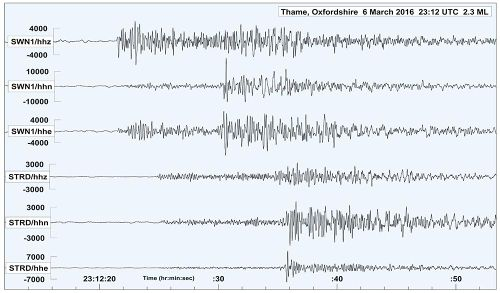
On 27 January, at 23:28 UTC, an earthquake with a magnitude of 0.8 ML, occurred near Penryn, Cornwall. A single felt report was received from a resident in the village of Rame, some 5 km to the west of the epicentre, who described “initially thought it was the quarry but it was a different sort of rumble” and “felt a weak vibration”, indicating an intensity of 2 EMS.
Two earthquakes, on 11 and 14 March, both with magnitudes of 1.0 ML, occurred near Oakham, Rutland, in the same area and at similar depths as the magnitude 3.8 ML Oakham event of 28 January 2015, which was felt throughout the region with a maximum intensity of 4 EMS. The 11 March event, at 20:30 UTC, was felt by several residents in Oakham, Langham, Burley, Barleythorpe and Cottsmore who described “there was a rumbling noise lasting for a couple of seconds”, “it was loud enough to hear over the television”, “sounded like a passing truck”, “very weak compared to previous earthquakes in the area” and “we thought it was a clap of thunder”, indicating an intensity of 3 EMS. The 14 March event, at 18:06 UTC, was felt by a few residents in Oakham, who described “felt a slight vibration through my feet” and “the kitchen window rattled”, indicating an intensity of 2 EMS.
On 13 April, at 13:11 UTC, an earthquake with a magnitude of 1.6 ML, occurred offshore the parish of St Martin, Guernsey, Channel Islands, around 6 km SSE of the capital, St Peter Port. The BGS received a few reports from residents of Guernsey which described, “a rattle, a rumble and then a thud” and “there was a rumbling noise, louder and deeper than our normal running machinery”, indicating an intensity of 2 EMS. It locates approximately 6 km NNW of the magnitude 4.3 ML Jersey earthquake on 11 July 2014, which was felt throughout the Channel Islands and was also felt in Devon, Dorset and in France, with a maximum intensity of 4 EMS. Historically, larger events have been known to occur in the area, the largest being a magnitude 4.4 ML earthquake on 22 December 1843, which caused a considerable amount of damage to buildings on Guernsey and caused panic among the inhabitants.
An earthquake with a magnitude of 1.7 ML occurred 9 km SSW of Hereford, Herefordshire, at 20:49 UTC, on 18 April. The BGS received two felt reports, from residents in the villages of Little Dewchurch and Much Dewchurch, who both described a slight shaking, indicating an intensity of 2 EMS. This event locates 5 km southwest of the magnitude 5.2 ML Hereford earthquake on 6 October 1863, which was felt throughout most of England and Wales, and caused minor damage in Hereford, Ross-on-Wye, Hay-on-Wye, Monmouth and Abergavenny. It also locates approximately 14 km WSW of the magnitude 5.3 ML Hereford earthquake which occurred on 17 December 1896, which was also felt throughout England and Wales and caused significant damage in Hereford and its surrounding villages, where over 200 chimneys were damaged or twisted.
A magnitude of 1.3 ML earthquake occurred at 11:25 UTC on 9 May, near Finnart, Perth and Kinross. A single report was received from a resident in the nearby village of Dall, which described, “the windows rattled and we felt a slight shudder”, indicating an intensity of 2 EMS.
On 17 May, at 15:56 UTC, a magnitude 1.9 ML earthquake occurred near Loch Goil, Argyll and Bute. The BGS received a single felt report, from the village of Lochgoilhead, which described, “felt a distinct vibration and heard a noise like thunder”, indicating an intensity of 2 EMS.
A magnitude 1.9 ML earthquake occurred, at 23:00 UTC, on 18 May, with an epicentre 2 km SSW of Oban, Argyll & Bute (Figure 8). Some 25 reports were received from residents of Oban and surrounding villages who felt the event, describing, “house vibrated slightly and ceiling creaked”, “slight shaking for a few seconds”, “badly fitted doors rattled”, “felt like a tube train went under the house” and “it was like a short rumble of thunder”, indicating an intensity of at least 3 EMS. It locates approximately 12 km southeast of the magnitude 4.1 ML Oban earthquake of 29 September 1986, which was felt over an area of around 30 000 km2 with a maximum intensity of 5 EMS. It also locates approximately 25 km NNW of the magnitude 5.2 ML Argyll earthquake on 28 November 1880, the largest of all recorded Scottish earthquakes, which was felt all along the west coast of Scotland, east as far as Perthshire, throughout the Inner and Outer Hebrides and extensively in Northern Ireland.
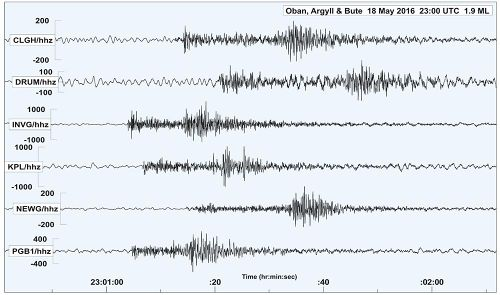
An earthquake with a magnitude of 1.3 ML, occurred at 04:10 UTC on 30 May, with a location near the village of Shieldaig, Highland. A single felt report was received from a resident of Charlestown, a small hamlet some 4 km NNW of the epicentre, who described, “the bed trembled”, indicating an intensity of 2 EMS.
On 13 June, at 21:40 UTC, a magnitude 1.9 ML earthquake occurred approximately 5 km south of the town and seaside resort of Colwyn Bay, Conwy (Figure 9). Some 48 reports were received from residents in Conwy, Gwynedd and Anglesey who reported feeling the event. The reports described , “a closed door rattled in its frame”, “low rumbling noise which lasted a few seconds”, “sounded like a jet with afterburners engaged”, “felt and sounded like a lorry going up the lane” and “thought the quarry had started blasting later than normal”, indicating an intensity of at least 3 EMS. This event locates approximately 10 km ENE of the magnitude 3.9 ML Llanrwst earthquake, on 29 August 1780, which was felt over more or less all of North Wales with maximum intensities of 5 EMS. It also locates approximately 50 km northeast of the magnitude 5.4 ML Lleyn Peninsula earthquake, on 19 July 1984, which was felt throughout England and Wales and into Scotland and Ireland, with a maximum intensity of 6 EMS. Historically, larger earthquakes have also been known to occur in the area, the largest being a magnitude 5.3 ML earthquake that occurred on 9 November 1852 and a magnitude 5.2 ML earthquake that occurred on 7 October 1690, which were both felt at intensities of 6 EMS.
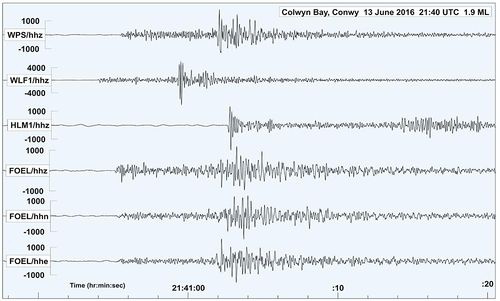
On 29 June, at 20:58 UTC, an earthquake with a magnitude of 1.4 ML occurred near the town of Middleton, Greater Manchester. The BGS received two felt reports from residents of Middleton, who described “both me and my husband felt the sofa shake” and “we felt quite a weak rumble”, indicating an intensity of 2 EMS.
Nine earthquakes, with magnitudes ranging between 0.9 ML and 1.9 ML, occurred on the Island of Mull, Argyll and Bute during the year. Two were reported felt. The largest occurred at 13:38 UTC on 19 August (Figure 10) and was felt in the hamlets of Lochbuie, Kinlochspelve, Killiechronan, Aros, Croggan, Craignure, Tiroran, Pennyghael and Gruline on the island. Reports described “sounded like thunder”, “we were mildly alarmed”, “there was a slight shaking at floor level” and “the windows rattled and there was a rumble through the kitchen floor”, indicating an intensity of at least 3 EMS. The other felt earthquake, with a magnitude of 1.2 ML, occurred, at 17:26 UTC, on 22 June, and was felt by a single resident in the hamlet of Tiroran, Mull, who described, “a faint vibration through the floor”. An intensity of 2 EMS was assigned to this event.
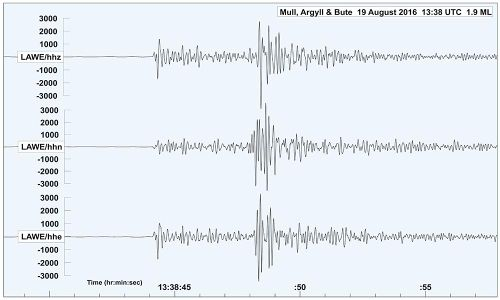
An earthquake, with a magnitude of 2.0 ML, occurred at 03:51 UTC on 2 November in the English Channel region, approximately 75 km southeast of Lizard Point, Cornwall. Three other offshore earthquakes occurred in the English Channel region during the year, with magnitudes of 1.2 ML, 1.6 ML and 1.9 ML. None were reported felt.
On 14 November, at 07:20 UTC, a magnitude 2.1 ML earthquake occurred approximately 4 km NNW of the town of Crickhowell, Powys. No felt reports were received for this event.